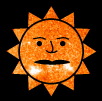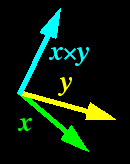 A night sky guide from The Solar Almanac.
A night sky guide from The Solar Almanac.
 A night sky guide from The Solar Almanac.
A night sky guide from The Solar Almanac.
by J. E. Brown
This constellation has a face and eyes, if you know where to look.
A Fish and a Goat
For thousands of years, the knowledge was passed from parent to child. Shepherds would tell their children, "Look. Up in the sky. See the sea-goat?" The children were puzzled, and asked, "How is that a sea-goat?" "Behold," said the parents, taking a glowing ember from the campfire, and using it to paint with light upon the night sky, to trace the curves of the two horns and the triangle of the tail. Capricornus is a magical beast. One of the few "constellations with eyes," its head and horns appear drawn with a special non-random precision, graceful and looping, with their stars suspiciously well lined up. The head and face are visible only to those with sharp eyesight, and only by the dark of the Moon. Among the oldest constellations, Capricornus was known by the Babylonians, but is increasingly hard for 21st century people to find, due to modern light pollution. Look for Capricornus every November, to the south at nightfall. And be sure to show it to someone. :^) Visibility:
|
Ptolemy's Version
Sometimes, when you really want to know a constellation, it pays to go to the source. The great astronomer Ptolemy had a different idea for Capricornus, and his pattern has been followed by many mapmakers to the present day. Ptolemy didn't leave drawings, but he left us a catalog of stars with specific anatomical instructions for labeling them (shown in full in Fig 2). Ptolemy's interpretation seems awfully contorted at first, but with a bit of staring, shapes appear. What I call the nose, Ptolemy saw as the line of the upper front legs. What I call the top of the horns makes up the midline down the chest and abdomen of Ptolemy's animal, and my trailing edge of the fish-tail traces out a believable backbone. What I call the eastern horn might even have inspired the looping tail found near Delta Capricorni in many maps. If we ignore the front legs, the constellation is shaped a bit like a sea horse. Ultimately, Ptolemy's Goat leaves me unsatisfied. My objection is that Ptolemy's Capricornus isn't terribly goatlike. There's no Taurus-like "v" shape in the head to evoke the image of horns. Nor does the tail suggest a tail. Most constellations are obvious when explained. Not Ptolemy's Goat. I wonder if Ptolemy would forgive me for reworking his star chart. The answer may be here:
|
J. E. Brown lives and breathes astronomy in Los Alamos, New Mexico USA.
constellations with faces, constellations with eyes, use of binoculars in astronomy
 The Solar Almanac: This month's events in astronomy. Never miss a moon event.
The Solar Almanac: This month's events in astronomy. Never miss a moon event.
 Vecpac, my C++ software for vector math and geometry
Vecpac, my C++ software for vector math and geometry

|
The Solar Almanac was conceived, computed, and produced for the web by: Copyright © 2006 J. E. Brown all rights reserved |